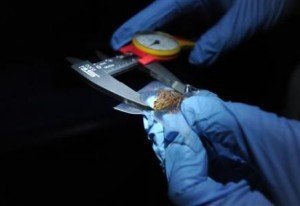 (Reuters) – The harlequin frog that hops and swims the rocky streams of a damp niche of Toad Mountain in eastern Panama’s dense tropical jungle has probably been on Earth for around 3 million years.
(Reuters) – The harlequin frog that hops and swims the rocky streams of a damp niche of Toad Mountain in eastern Panama’s dense tropical jungle has probably been on Earth for around 3 million years.Within a few more years, the black-spotted orange-and-white amphibian with dazzling green-tinged eyes is likely to be wiped off the map by a deadly fungus, scientists say.
Known as Atelopus certus, it is among those left on the hit list of the parasitic fungus frog chytrid (Batrachochytrium dendrobatidis) which has helped to hasten the decline or extinction of 200 species from California’s Sierra Nevada to Australia, and could threaten hundreds more.
Believed to be spread by human activity, the fast-acting pathogen has become a symbol of how mankind is contributing to the widespread extinction of species, climate change and rising sea levels.
Conservationists describe the multicolored amphibians as sitting on the cusp of oblivion and efforts to save them and other unidentified species are converging on Panama’s Darien, one of the last places still partly free from the fungus.
Yet the world may never learn about many of Darien’s rare amphibians, said Joe Mendelson, Zoo Atlanta’s herpetology curator, who describes new species as they fade from the wild.
“They are going away sometimes before I even named them,” he said. “I got into this business because I want to work with live animals. And now I’m just working with the modern equivalent of extinct dinosaurs. It’s really unsettling.”
Worldwide, more than 40 percent of amphibians are in decline from habitat loss, pollution and the fungal plague. Many scientists believe the amphibian plight is a bellwether for the changing planet’s eventual impact on flora and fauna.
“The chytrid fungus is part of a much wider phenomenon,” said Jan Zalasiewicz of the University of Leicester in England, a leading expert on the Anthropocene, an informal term for a destructive epoch started by the Industrial Revolution.
The speed of the chytrid threat is making scientists who describe living animals feel like paleontologists, as signs increase that this new geological age is occurring in a fraction of the time they did in the past.
“From the far future the effects of human action will probably be indistinguishable from that of the meteor strike that likely killed off the dinosaurs,” Zalasiewicz said.
ROAMING DRUG RUNNERS
The remote and dangerous Darien, once famed as the scene of Scotland’s disastrous attempt to establish an overseas empire is one of the battlegrounds as scientists try to stop, or at least slow, the demise of species.
While hummingbirds buzz around a steep slippery creek, large royal-blue butterflies shimmer in sunlight and venomous snakes slither beneath fallen leaves, Roberto Ibanez attempts to collect harlequin frogs in rock streams beneath the mountain’s cloud forest summit.
“There’s so much to do and so little time,” he said.
Ibanez, of Panama’s Smithsonian Tropical Research Institute, was among the first amphibian experts to go to Toad Mountain in three decades, and he reckons as many as 40 species remain in Panama that could be susceptible to chytrid.
“We won’t be able to do anything for the rest, unless the project somehow expands with sufficient funds, personnel and equipment – and quickly,” said Ibanez, whose team was halted for hours by police en route to Cerro Sapo, characteristic of the unpredictable security in the region.
Large swaths of the province are off-limits as Colombian rebels-turned-drug traffickers stalk the remote, sparsely populated area on the Colombian border.
A lack of resources and political will in Panama may sound the death knell for many of Darien’s endangered amphibians.
“The fungus will cause the extinction of many species that we are not familiar with,” said Ibanez, who estimates Toad Mountain will remain chytrid-free for three years at best.
Because Atelopus certus is one of the few amphibians at risk from chytrid that exist in captivity, scientists hope they can offer it a lifeline.
PULLING THE TRIGGER
Frog chytrid was described in 1998, as separate groups of scientists in the United States, Australia and Central America pooled research on frog declines and found the killer.
The fungus kills by causing a skin infection that hampers an amphibian’s vital functions, leading to cardiac arrest.
How chytrid spread is unclear, though trade in exotic frogs and the introduction of African species have been suggested.
Many experts are gloomy about stopping chytrid’s advance, though hope may lie in California’s Sierra Nevada, where an effort to inoculate the frogs is underway.
Just before the fungus arrived in Sierra Nevada last year, San Francisco State University biologist Vance Vredenburg bathed dozens of frogs in a solution of anti-chytrid bacteria.
“The fungus showed up and killed off all the frogs in the basin — except for the one I was working on,” he said.
However, Panama’s frogs have proved resistant to his bacteria. Finding a different chytrid-fighting bacteria native to Panama’s frogs may provide the key, Vredenburg said.
Climate change has long been suspected in the chytrid spread but no clear link between the two has yet been made.
“It may be that under normal circumstances the chytrid, the fungus, wouldn’t be this damaging, but given all the other conditions that we’ve created, it’s kind of this perfect storm,” said Robin Moore of Conservation International.
“The chytrid may be pulling the trigger but the gun is being loaded by many other factors.”
By Sean Mattson
CERRO SAPO, Panama | Fri Jun 10, 2011 3:12pm EDT